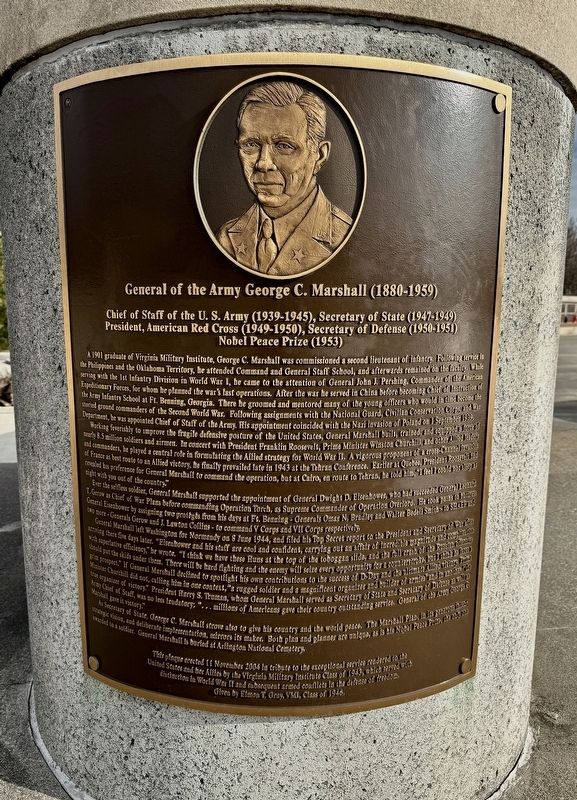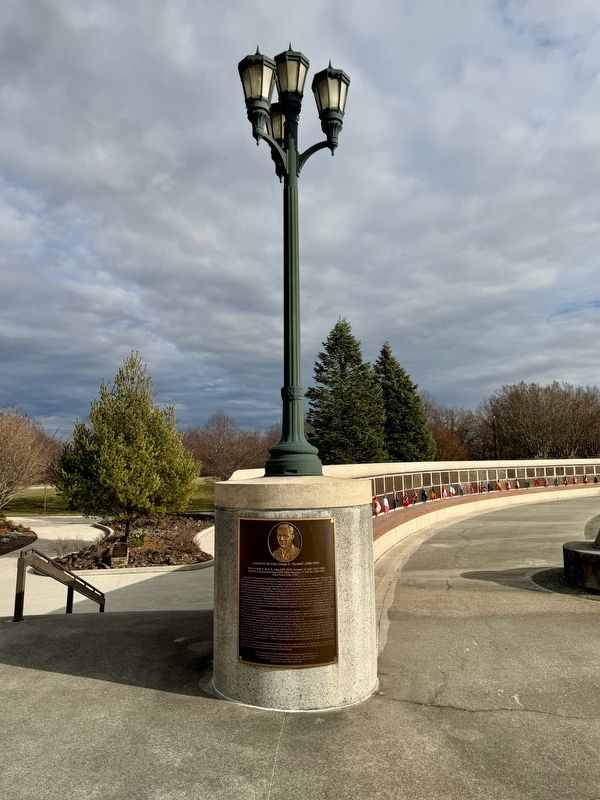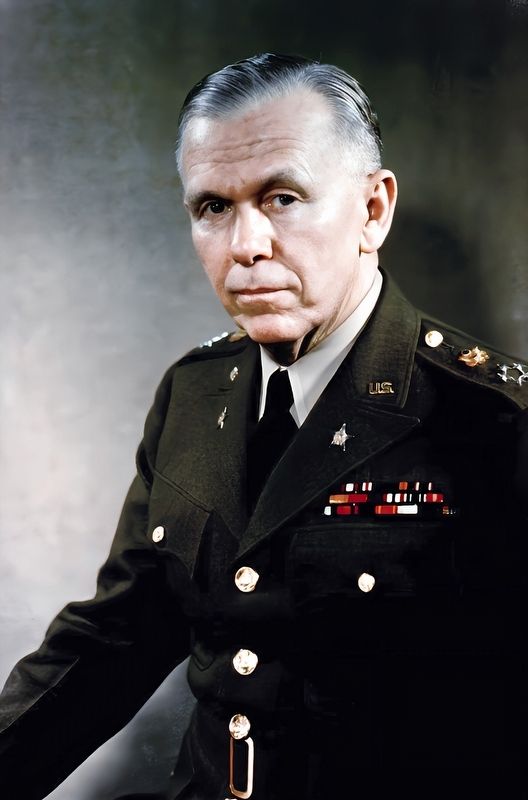Bedford in Bedford County, Virginia — The American South (Mid-Atlantic)
General of the Army George C. Marshall (1880-1959)
— National D-Day Memorial —
General of the Army George C. Marshall (1880-1959)
Chief of Staff of the U.S. Army (1939-1945), Secretary of State (1947-1949)
President, American Red Cross (1949-1950), Secretary of Defense (1950-1951)
Nobel Peace Prize (1953)
A 1901 graduate of Virginia Military Institute, George C. Marshall was commissioned a second lieutenant of infantry. Following service in the Philippines and the Oklahoma Territory, he attended Command and General Staff School, and afterwards remained on the faculty. While serving with the 1st Infantry Division in World War I, he came to the attention of General John J. Pershing, Commander of the American Expeditionary Forces, for whom he planned the war's last operations. After the war he served in China before becoming Chief of Instruction of the Army Infantry School at Ft. Benning, Georgia. There he groomed and mentored many of the young officers who would in time become the storied commanders of the Second World War. Following assignments with the National Guard, Civilian Conservation Corps, and War Department, he was appointed Chief of Staff of the Army. His appointment coincided with the Nazi invasion of Poland on 1 September 1939.
Working feverishly to improve the fragile defensive posture of the United States, General Marshall built, trained, and equipped a force of nearly 8.5 million soldiers and airmen. In concert with President Franklin Roosevelt, Prime Minister Winston Churchill, and other allied leaders and commanders, he played a central role in formulating the Allied strategy for World War II. A vigorous proponent of a cross-Channel invasion of France as best route to an Allied victory, he finally prevailed late in 1943 at the Tehran Conference. Earlier at Quebec, President Roosevelt had revealed his preference for General Marshall to command the operation, but at Cairo, en route to Tehran, he told him, “I feel I could not sleep at night with you out of the country.”
Ever the selfless soldier, General Marshall supported the appointment of General Dwight D. Eisenhower, who had succeeded General Leonard T. Gerow as Chief of War Plans before commanding Operation Torch, as Supreme Commander of Operation Overlord. He took pains to buttress General Eisenhower by assigning two protégés from his days at Ft. Benning - Generals Omar N. Bradley and Walter Bedell Smith - to SHAEF and two more - Generals Gerow and J. Lawton Collins - to command V Corps and VII Corps respectively.
General Marshall left Washington for Normandy on 8 June 1944, and filed his Top Secret report to the President and Secretary of War after arriving there five days later. “Eisenhower and his staff are cool and confident, carrying out an affair of incredible magnitude complexion with superlative efficiency,” he wrote. “I think we have these Huns at the top of the toboggan slide, and the full crash of the Russian offensive should put the skids under them. There will be hard fighting and the enemy will seize every opportunity for a counterstroke, but I think he faces a grim prospect.” If General Marshall declined to spotlight his own contributions to the success of D-Day and the ultimate Allied victory, Prime Minister Winston Churchill did not, calling him in one context, “a rugged soldier and a magnificent organizer and builder of armies” and in another “the true organizer of victory.” President Harry S. Truman, whom General Marshall served as Secretary of State and Secretary of Defense as well as Army Chief of Staff, was no less laudatory.” … millions of Americans gave their country outstanding service, General of the Army George C. Marshall gave it victory.”
As Secretary of State, George C. Marshall strove also to give his country and the world peace. The Marshall Plan, in its generous intent, strategic vision, and deliberate implementation, mirrors its maker. Both plan and planner are unique, as is his Nobel Peace Prize, the only one awarded to a soldier. General Marshall is buried at Arlington National Cemetery.
This plaque erected 11 November 2004 in tribute to the exceptional service rendered to the United States and her Allies by the Virginia Military Institute Class of 1943, which served with distinction in World War II and subsequent armed conflicts in the defense of freedom. Given by Elmon T. Gray, VMI, Class of 1946.
Erected 2004 by National D-Day Memorial and the Virginia Military Institute Class of 1943.
Topics and series. This memorial is listed in these topic lists: Military • Peace • War, World II. In addition, it is included in the U.S. National D-Day Memorial series list. A significant historical date for this entry is June 6, 1944.
Location. 37° 19.852′ N, 79° 32.152′ W. Marker is in Bedford, Virginia, in Bedford County. Memorial can be reached from Overlord Circle, 0.4 miles west of Burks Hill Road. The Marker is located on the grounds of the National D-Day Memorial. Touch for map. Marker is at or near this postal address: 3 Overlord Circle, Bedford VA 24523, United States of America. Touch for directions.
Other nearby markers. At least 8 other markers are within walking distance of this marker. Third Infantry Division (British) (here, next to this marker); Six Airborne Division (British) (here, next to this marker); 4th Special Service Brigade (Commandos) (here, next to this marker); 1st Special Brigade (Commandos) (here, next to this marker); Third Canadian Infantry Division (here, next to this marker); 50th (Northumbrian) Infantry Division (here, next to this marker); The United States Marines in the European Theater (here, next to this marker); French Forces of the Interior (FFI) (here, next to this marker). Touch for a list and map of all markers in Bedford.
Also see . . .
1. George C. Marshall. (Submitted on February 5, 2024, by Brandon D Cross of Flagler Beach, Florida.)
2. National D-Day Memorial. (Submitted on February 5, 2024, by Brandon D Cross of Flagler Beach, Florida.)
Credits. This page was last revised on February 6, 2024. It was originally submitted on February 5, 2024, by Brandon D Cross of Flagler Beach, Florida. This page has been viewed 52 times since then. Photos: 1, 2, 3. submitted on February 5, 2024, by Brandon D Cross of Flagler Beach, Florida. • Andrew Ruppenstein was the editor who published this page.


